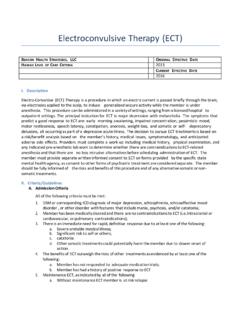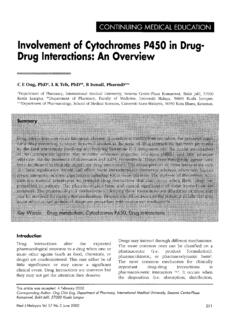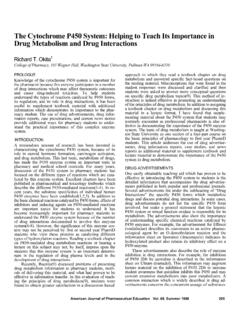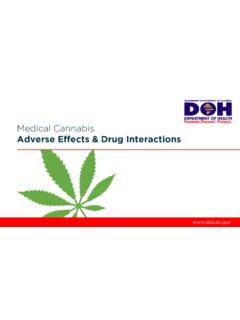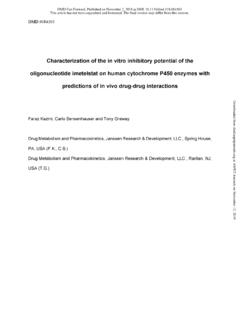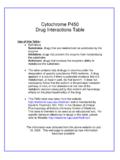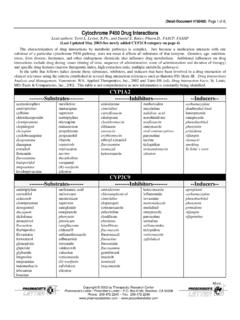Transcription of Cytochrome p450 Genotyping - 9/1/16
1 Cytochrome p450 Genotyping Policy Number: Original Effective Date: 04/01/2011 Line(s) of Business: Current Effective Date: HMO; PPO; QUEST Integration 09/01/2016 Section: Medicine Place(s) of Service: Laboratory I. Description The Cytochrome p450 (CYP450) family is involved in the metabolism of a significant proportion of currently administered drugs, and genetic variants in Cytochrome p450 are associated with altered metabolism of many drugs. Genetic testing for Cytochrome p450 variants may assist in selecting and dosing drugs that are impacted by these genetic variants. CYP450 Genotyping has been demonstrated in a number of studies to identify increased risk of thrombosis in patients with coronary disease or cardiac interventions being considered as candidates for clopidogrel treatment. This observation is most pronounced for stent thrombosis in patients undergoing percutaneous coronary intervention (PCI). Genotyping may be used to consider treatment alternatives, eg, higher doses of clopidogrel or alternative drug choices.
2 The ood and drug Administration (FDA) has created a black box warning indicating testing should be considered. Clinical input from academic medical centers and specialty societies was mixed concerning the benefit of genetic testing, but there was not consensus that the medically necessary determination be changed. As a result, genetic testing for selection and dosing of clopidogrel may be considered medically necessary. The FDA labeling for the orphan drugs eliglustat (for Gaucher disease) and tetrabenazine (for Huntington disease) recommends CYP2D6 Genotyping before use. There is limited published evidence about outcome changes associated with genotype-directed therapy for these medications. However, given the FDA labeling and the high variation in drug exposure based on metabolizer status, Genotyping of CYP2D6 to determine metabolizer status before the use of these drugs is reasonable and may be considered medically necessary. For other medications, most published CYP450 pharmacogenomic studies are retrospective evaluations of CYP450 genotype association with intermediate (eg, circulating drug concentrations) or, less often, final outcomes (eg, adverse events or efficacy) and are largely small and underpowered or not designed to examine the clinical effects of homozygous variant poor metabolizers (PMs) and of ultrarapid metabolizers (UM), where the strongest effects, if any, would be seen.
3 The hazards associated with PMs are consequently difficult to interpret and decision making about how to use Genotyping information is poorly defined with uncertain outcomes. As a result, for the indications below, CYP450 Genotyping is not covered. This includes, but is not limited to, CYP450 Genotyping for the following: selection or dosing of selective serotonin reuptake inhibitors (SSRIs) selection or dosing of selective norepinephrine reuptake inhibitors (SNRIs) and serotonin- norepinephrine reuptake inhibitors selection or dosing of tricyclic antidepressants selection or dosing of antipsychotic drugs selection or dosage of codeine dosing of efavirenz and other antiretroviral therapies for HIV infection. dosing of immunosuppressant for organ transplantation selection or dosing of beta blockers (eg, metoprolol) dosing and management of antituberculosis medications Because the clinical utility of genetic testing for individual CYP450 polymorphisms has not demonstrated clinical utility, the use of genetic panel testing for CYP450 polymorphisms is not covered.
4 This policy does not address the use of panels of genetic tests that include tests for genes other than CYP450-related genes (eg, the Genecept Assay), which are discussed in the Genetic Testing for Mental Health Conditions. II. Criteria/Guidelines A. CYP450 Genotyping is covered (subject to Limitations and Administrative Guidelines) once per lifetime for the purpose of aiding in the choice of clopidogrel (Plavix) versus alternative anti- platelet agents, or in decisions on the optimal dosing of clopidogrel. B. CYP450 Genotyping is covered (subject to Limitations and Administrative Guidelines) once per lifetime to determine drug metabolizer status for patients: 1. With Gaucher disease being considered for treatment with eliglustat; or 2. With Huntington disease being considered for treatment with tetrabenazine in a dosage greater than 50 mg per day III. Limitations A. CYP450 Genotyping for the purpose of aiding in the choice of drug or dose to increase efficacy and/or avoid toxicity is not medically necessary for all other drugs, including not limited to the following applications: 1.
5 Selection or dosing of selective serotonin reuptake inhibitor (SSRI) 2. Selection or dosing of antipsychotic drugs 3. Selection of dosing of codeine 4. Selection and dosing of selective norepinephrine reuptake inhibitors and serotonin- norepinephrine reuptake inhibitors 5. Selection and dosing of tricyclic antidepressants 6. Dosing of efavirenz and other antiretroviral therapies for HIV 7. Dosing of immunosuppressant for organ transplantation 8. Selection or dose of beta blockers ( , metoprolol) 9. Dosing and management of anti-tuberculosis medications Cytochrome p450 Genotyping 4 B. CYP450 Genotyping for CYP2C19 is limited to once per lifetime. C. The use of genetic panels that include multiple CYP450 mutations are not covered. IV. Administrative Guidelines A. Precertification is not required. HMSA reserves the right to perform retrospective review using the above criteria to validate if services rendered met payment determination criteria. B. Applicable CPT codes: CPT Description 81225 CYP2C19 ( Cytochrome p450 , family 2, subfamily C, polypeptide 19) , drug metabolism, gene analysis, common variants , *2, *3, *4, *8, *17 81226 CYP2D6 ( Cytochrome p450 , family 2, subfamily D, polypeptide 6) (eg, drug metabolism), gene analysis, common variants (eg, *2, *3, *4, *5, *6, *9, *10, *17, *19, *29, *35, *41, *1XN, *2XN, *4XN) ICD-10 Description Gaucher disease G10 Huntington's disease Intermediate coronary syndrome (unstable angina) Acute myocardial infarction code range Post-myocardial infarction syndrome (Dressler s syndrome) Atherosclerotic heart disease of native coronary artery with unstable angina pectoris Occlusion and stenosis of cerebral arteries, resulting in cerebral infarction, code range Occlusion and stenosis of cerebral arteries, not resulting in cerebral infarction, code range I73 Other peripheral vascular disease V.
6 Background drug efficacy and toxicity vary substantially across individuals. Because drugs and doses are typically adjusted, if needed, by trial and error, clinical consequences may include a prolonged time to optimal therapy. In some cases, serious adverse events may factors may influence the variability of drug effects, including age, liver function, concomitant diseases, nutrition, smoking, and drug - drug interactions. Inherited (germline) DNA sequence variation (polymorphisms) in genes coding for drug metabolizing enzymes, drug receptors, drug transporters, and molecules involved in signal transduction pathways also may have major effects on the activity of those molecules and thus on the efficacy or toxicity of a drug . Pharmacogenomics is the study of how an individual's genetic inheritance affects the body's response to drugs. It may be possible to predict therapeutic failures or severe adverse drug reactions in individual patients by testing for important DNA polymorphisms ( Genotyping ) in genes related to the metabolic Cytochrome p450 Genotyping 5 pathway (pharmacokinetics) or signal transduction pathway (pharmacodynamics) of the drug .
7 Potentially, test results could be used to optimize drug choice and/or dose for more effective therapy, avoid serious adverse effects, and decrease medical costs. Cytochrome p450 System The Cytochrome p450 (CYP450) family is a major subset of all drug -metabolizing enzymes; several CYP450 enzymes are involved in the metabolism of a significant proportion of currently administered drugs. CYP2D6 metabolizes approximately 25% of all clinically used medications (eg, dextromethorphan, beta-blockers, antiarrhythmics, antidepressants, and morphine derivatives), including many of the most prescribed drugs. CYP2C19 metabolizes several important types of drugs, including proton pump inhibitors, diazepam, propranolol, imipramine, and amitriptyline. Some CYP450 enzyme genes are highly polymorphic, resulting in some enzyme variants that have variable metabolic capacities among individuals, and some with little to no impact on activity. Thus, CYP450 enzyme variants constitute one important group of drug -gene interactions influencing the variability of effect of some CYP450 metabolized drugs.
8 Individuals with two copies (alleles) of the most common (wild type) DNA sequence of a particular CYP450 enzyme gene resulting in an active molecule are termed extensive metabolizers (EMs; normal). Poor metabolizers (PMs) lack active enzyme gene alleles, and intermediate metabolizers (IMs), who have one active and one inactive enzyme gene allele, may experience to a lesser degree some of the consequences of poor metabolizers. Ultrarapid metabolizers (UMs) are individuals with more than two alleles of an active enzyme gene. There is pronounced ethnic variability in the population distribution of metabolizer types for a given CYP enzyme. Ultrarapid metabolizers administered an active drug may not reach therapeutic concentrations at usual, recommended doses of active drugs, while PMs may suffer more adverse events at usual doses due to reduced metabolism and increased concentrations. Conversely, for administered prodrugs that must be converted by CYP450 enzymes into active metabolites, UMs may suffer adverse effects and PMs may not respond.
9 Many drugs are metabolized to varying degrees by more than one enzyme, either within or outside of the CYP450 superfamily. In addition, interaction between different metabolizing genes, interaction of genes and environment, and interactions among different non-genetic factors also influence CYP450-specific metabolizing functions. Thus, identification of a variant in a single gene in the metabolic pathway may be insufficient in all but a small proportion of drugs to explain inter- individual differences in metabolism and consequent efficacy or toxicity. Determining Genetic Variability in drug Response Genetically determined variability in drug response has been traditionally addressed using a trial and error approach to prescribing and dosing, along with therapeutic drug monitoring (TDM) for drugs with a very narrow therapeutic range and/or potential serious adverse effects outside that range. However, TDM is not available for all drugs of interest, and a cautious trial and error approach can lengthen the time to achieving an effective dose.
10 CYP450 enzyme phenotyping (identifying metabolizer status) can be accomplished by administering a test enzyme substrate to a patient and monitoring parent substrate and metabolite concentrations over time ( , in urine). However, testing and interpretation are time-consuming and inconvenient; as a result, phenotyping is seldom performed. The clinical utility of CYP450 Genotyping , , the likelihood that Genotyping will significantly improve drug choice/dosing and consequent patient outcomes, is favored when the drug under consideration has a Cytochrome p450 Genotyping 6 narrow therapeutic dose range (window), when the consequences of treatment failure are severe, and/or when serious adverse reactions are more likely in patients with gene sequence variants. Under these circumstances, Genotyping may direct early selection of the most effective drug or dose, and/or avoid drugs or doses likely to cause toxicity. For example, warfarin, some neuroleptics, and tricyclic antidepressants have narrow therapeutic windows and can cause serious adverse events when concentrations exceed certain limits, resulting in cautious dosing protocols.
